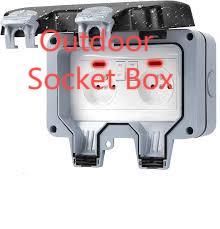Nante Implementation Notes: Outdoor Socket Box Standards for Scalable Power Networks

Planners and technicians increasingly choose the Outdoor Socket Box when they need a compact, serviceable way to provide local power and protection in public and private sites. Early coordination between design teams and field crews helps ensure the enclosure matches mounting constraints, access patterns, and seasonal exposure — reducing callbacks and simplifying long-term upkeep.
Assessing Site Conditions Before Installation
Successful deployments begin with realistic site surveys. Teams document clearances, likely cable routes, and potential sources of contamination such as dust corridors or splash zones. Understanding how wind, sun, and nearby activity influence wear helps specify mounting height, bracket choices, and whether additional shielding or drainage will be required. These early choices pay off when crews execute installations that do not require on-the-fly modifications.
Simplifying Power Distribution at the Edge
Small distribution boxes make it practical to decentralize simple circuits without large conduit runs. By bringing terminations closer to devices, installers minimize cable length and reduce voltage concerns for sensitive sensors or low-power controllers. Thoughtful internal layouts, dedicated cable entry zones, and separation of control and load paths all contribute to tidy, auditable installations that ease future upgrades.
Nante Accessories and Compatibility
Accessory compatibility speeds field work. When enclosure families accept common mounting plates, gland sets, and labeling frames, crews spend less time fabricating onsite and more time finishing reliably. Standard accessory kits promote predictable spare inventories and simplify acceptance testing across multiple projects, letting teams swap parts without searching for obscure components.
Installation Practices That Reduce Returns
Field feedback highlights a few recurring details: hinge geometry that keeps panels open during work, fasteners designed to minimize drop-loss, and interior labeling that remains legible after years of sun exposure. When work instructions include torque sequences, cable-bend radii, and photo verification steps, installers follow consistent methods. Those methods reduce rework and build a visual record useful for audits and lifecycle planning.
Inspection, Training, and Documentation
A robust program combines scheduled inspections with ongoing training. Inspection checklists should note gasket condition, cable entry seals, and hardware tightness; photographic signoffs create a searchable history that teams can analyze for wear trends. Training sessions that replicate tight mounting conditions or nocturnal inspections prepare crews for the awkward realities of site work, improving first-visit success rates.
Environmental and Lifecycle Considerations
Durability matters beyond initial installation. Choosing enclosures whose interiors support modular swaps allows technicians to upgrade internal components without discarding the outer shell. Planning for refurbishment and recycling at end of life reduces waste and can lower total ownership costs. When procurement includes clear expectations for reuse or remanufacture, organizations preserve value as electronics evolve.
Use Cases Across Sectors
Municipal lighting and signaling, campus charging points, temporary event power, and remote monitoring all benefit from compact power enclosures. Each use case relies on predictable access, clear labeling, and simple maintenance routes. With repeatable specifications, organizations manage spares more efficiently and maintain steady service levels across many nodes rather than fixing problems piecemeal.
Scaling Successfully
Pilot projects are invaluable for exposing practical constraints—nighttime readability, ladder placement, or unexpected moisture paths—that refine standards for larger rollouts. With those lessons in hand, teams can scale deployments confidently: the right spares at the depot, clear documentation templates, and consistent accessory kits mean rollouts expand without multiplying operational headaches. For product details and compatible accessories, please see www.nante.com/product/ .
- Vibnix Blog
- Politics
- News
- Liberia News
- Entertainment
- Technology
- Educação
- Art
- Causes
- Crafts
- Dance
- Drinks
- Film
- Fitness
- Food
- Jogos
- Gardening
- Health
- Início
- Literature
- Music
- Networking
- Outro
- Party
- Religion
- Shopping
- Sports
- Theater
- Wellness


